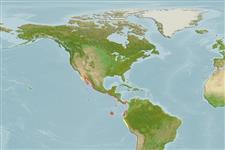Environment: milieu / climate zone / depth range / distribution range
ນິເວດວິທະຍາ
ສັດທະເລ ກ່ຽວກັນຫີນ; ລະດັບຄວາມເລິກ 21 - 40 m (Ref. 5222). Subtropical; 33°N - 13°S, 118°W - 76°W (Ref. 5222)
Eastern Pacific: southern California, USA to Peru, including Revillagigedo and Galapagos Islands, Cocos Island, Clipperton Island.
ຂະໜາດ / ນ້ຳໜັກ / Age
Maturity: Lm ? range ? - ? cm
Max length : 100.0 cm TL ຕົວຜູ້/ບໍ່ມີເພດ; (Ref. 5222); ນ້ຳໜັກສູງສຸດທີ່ເຄຍຈັດພີມມາ: 12.5 kg (Ref. 4699)
ຄີ (ໜາມ)ແຂງຢູ່ຫຼັງປາ (ທັງໝົດ) : 11; ຄີຫຼັງຂອງປາ (ຄີອ່ອນ) (ທັງໝົດ) : 18 - 20; ຄີ(ໜາມ) ແຂງຢູ່ຄີກົ້ນປາ
ກຸ່ມປາກະດູກແຂງ
ຄວາມຖີ່ຂອງກຸ່ມຖ່າຍທອດພັນ
ປາທີ່ມີການເຄື່ອນຍ້າຍຈາກທະເລໄປຫານ້ຳຈືດ ແລະນ້ຳຈືດຫາທະເລ
ປາທີ່ມີການເຄື່ອນຍ້າຍຈາກທະເລແລະໄປໄຂ່ຢູ່ນ້ຳຈືດ
ຄີກົ້ນຂອງປາ
ສັດທີ່ມີກະດູກສັນຫັຼງ
ການຖ່າຍທອດທາງກຳມະພັນຈາກພໍ່ແມ່ຫາລູກ: 3; ຄີກົ້ນຂອງປາ: 9. Distinguished by the following characteristics: body depth, 2.1-2.5 in SL; dorsal profile of head is steep; eye diameter less than snout length, 5.2-8.0 in HL; short pectoral fins, length 18-26% of SL; rounded caudal fin; smooth scales, mostly covered by skin; lateral line scales 62-67 (Ref. 089707).
A diurnal predator that feeds on small benthic fishes and occasionally on crustaceans. Often it uses browsing herbivorous fishes as a moving blind in order to feed on the cryptic fauna disturbed by these browsers; it will also follow foraging moray eels to catch the fishes frightened from their hiding places. Small juveniles have been seen hiding among the long spines of the dark-colored sea urchin, Centrostephanus coronatus.
Life cycle and mating behavior
Maturities | ການສືບພັນ | Spawnings | Egg(s) | Fecundities | ຕົວອ່ອນ
Heemstra, P.C. and J.E. Randall, 1993. FAO Species Catalogue. Vol. 16. Groupers of the world (family Serranidae, subfamily Epinephelinae). An annotated and illustrated catalogue of the grouper, rockcod, hind, coral grouper and lyretail species known to date. Rome: FAO. FAO Fish. Synop. 125(16):382 p. (Ref. 5222)
IUCN Red List Status (Ref. 130435)
Can't connect to MySQL database (fbapp). Errorcode: Too many connections
